Taxation Law of Australia Assignment: Case Studies and Analysis
VerifiedAdded on 2020/02/18
|12
|3170
|44
Homework Assignment
AI Summary
This document presents a comprehensive solution to an Australian Taxation Law assignment. It addresses two key questions, providing detailed advice on the tax treatment of various items under Australian tax law, such as flyer points, property damage payments, holiday packages, and travel expenses. The assignment analyzes each scenario, referencing relevant Australian tax rulings and legislation to support the advice. Furthermore, the solution includes the calculation of an individual's taxable income for the 2016/17 financial year, incorporating gross salary, foreign income, and deductions. The analysis covers key concepts like taxable income, deductions, fringe benefits tax, and capital assets, offering practical insights into the application of Australian tax law. The document incorporates citations to relevant academic and professional sources.
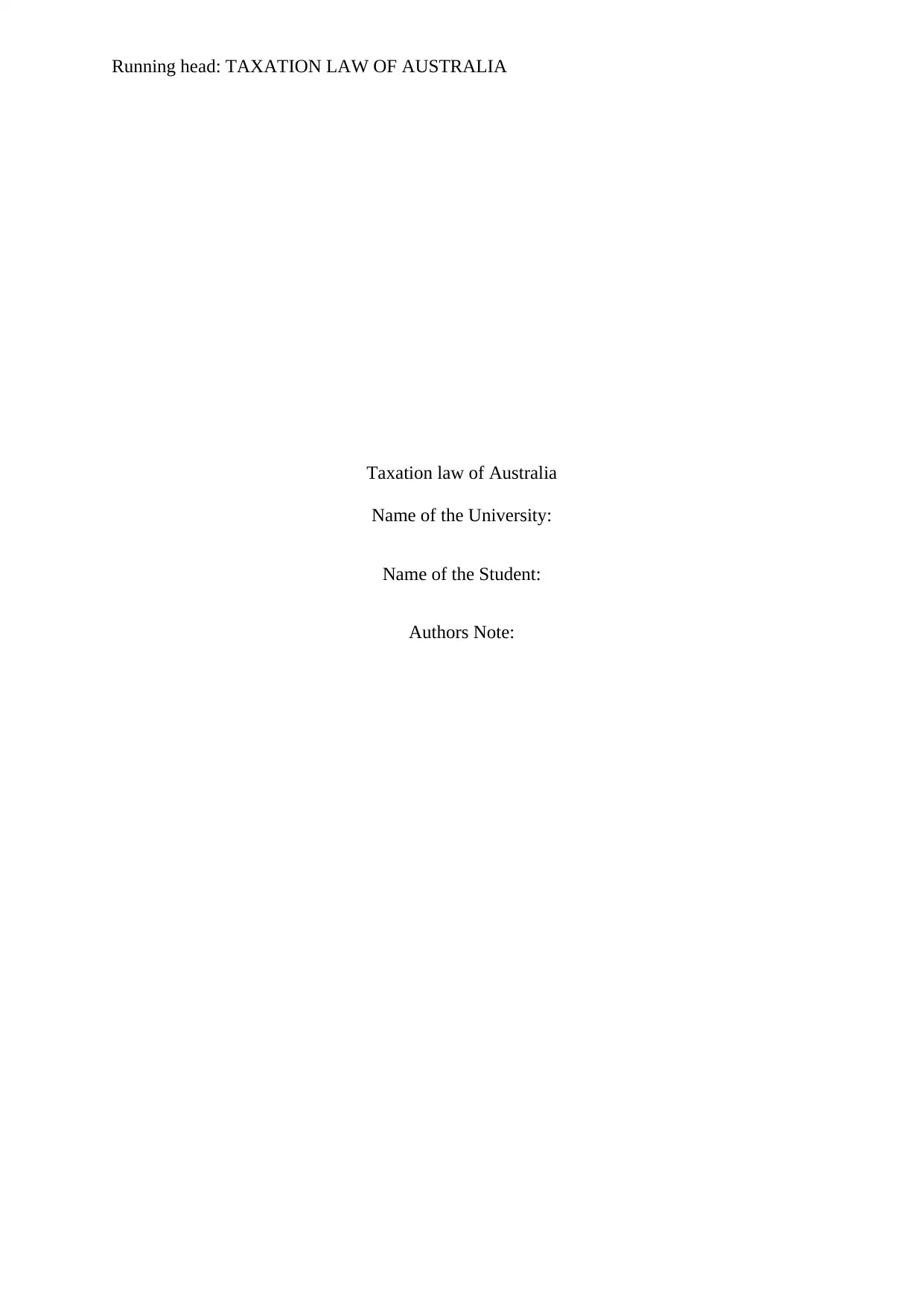
Running head: TAXATION LAW OF AUSTRALIA
Taxation law of Australia
Name of the University:
Name of the Student:
Authors Note:
Taxation law of Australia
Name of the University:
Name of the Student:
Authors Note:
Paraphrase This Document
Need a fresh take? Get an instant paraphrase of this document with our AI Paraphraser
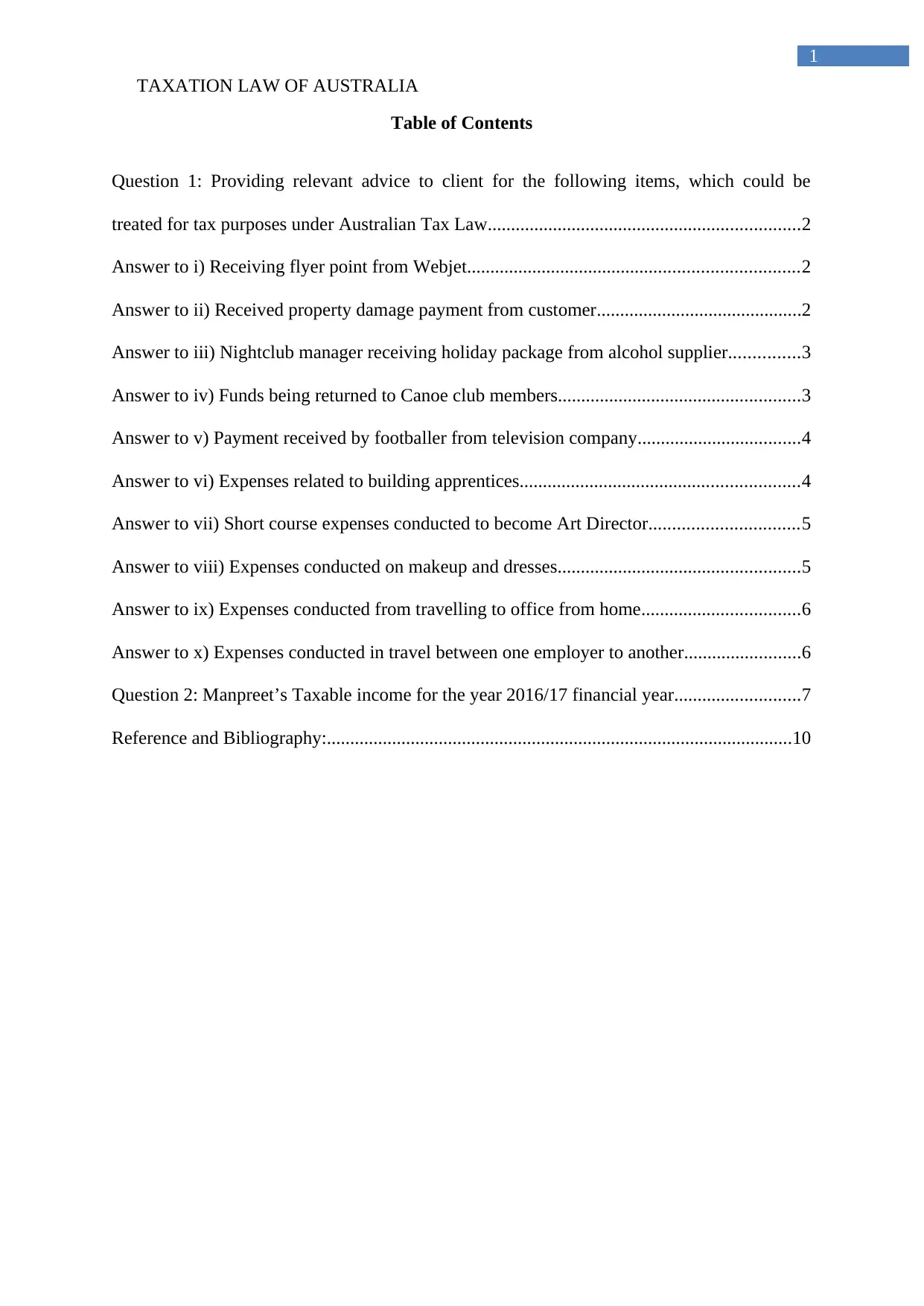
1
TAXATION LAW OF AUSTRALIA
Table of Contents
Question 1: Providing relevant advice to client for the following items, which could be
treated for tax purposes under Australian Tax Law...................................................................2
Answer to i) Receiving flyer point from Webjet.......................................................................2
Answer to ii) Received property damage payment from customer............................................2
Answer to iii) Nightclub manager receiving holiday package from alcohol supplier...............3
Answer to iv) Funds being returned to Canoe club members....................................................3
Answer to v) Payment received by footballer from television company...................................4
Answer to vi) Expenses related to building apprentices............................................................4
Answer to vii) Short course expenses conducted to become Art Director................................5
Answer to viii) Expenses conducted on makeup and dresses....................................................5
Answer to ix) Expenses conducted from travelling to office from home..................................6
Answer to x) Expenses conducted in travel between one employer to another.........................6
Question 2: Manpreet’s Taxable income for the year 2016/17 financial year...........................7
Reference and Bibliography:....................................................................................................10
TAXATION LAW OF AUSTRALIA
Table of Contents
Question 1: Providing relevant advice to client for the following items, which could be
treated for tax purposes under Australian Tax Law...................................................................2
Answer to i) Receiving flyer point from Webjet.......................................................................2
Answer to ii) Received property damage payment from customer............................................2
Answer to iii) Nightclub manager receiving holiday package from alcohol supplier...............3
Answer to iv) Funds being returned to Canoe club members....................................................3
Answer to v) Payment received by footballer from television company...................................4
Answer to vi) Expenses related to building apprentices............................................................4
Answer to vii) Short course expenses conducted to become Art Director................................5
Answer to viii) Expenses conducted on makeup and dresses....................................................5
Answer to ix) Expenses conducted from travelling to office from home..................................6
Answer to x) Expenses conducted in travel between one employer to another.........................6
Question 2: Manpreet’s Taxable income for the year 2016/17 financial year...........................7
Reference and Bibliography:....................................................................................................10
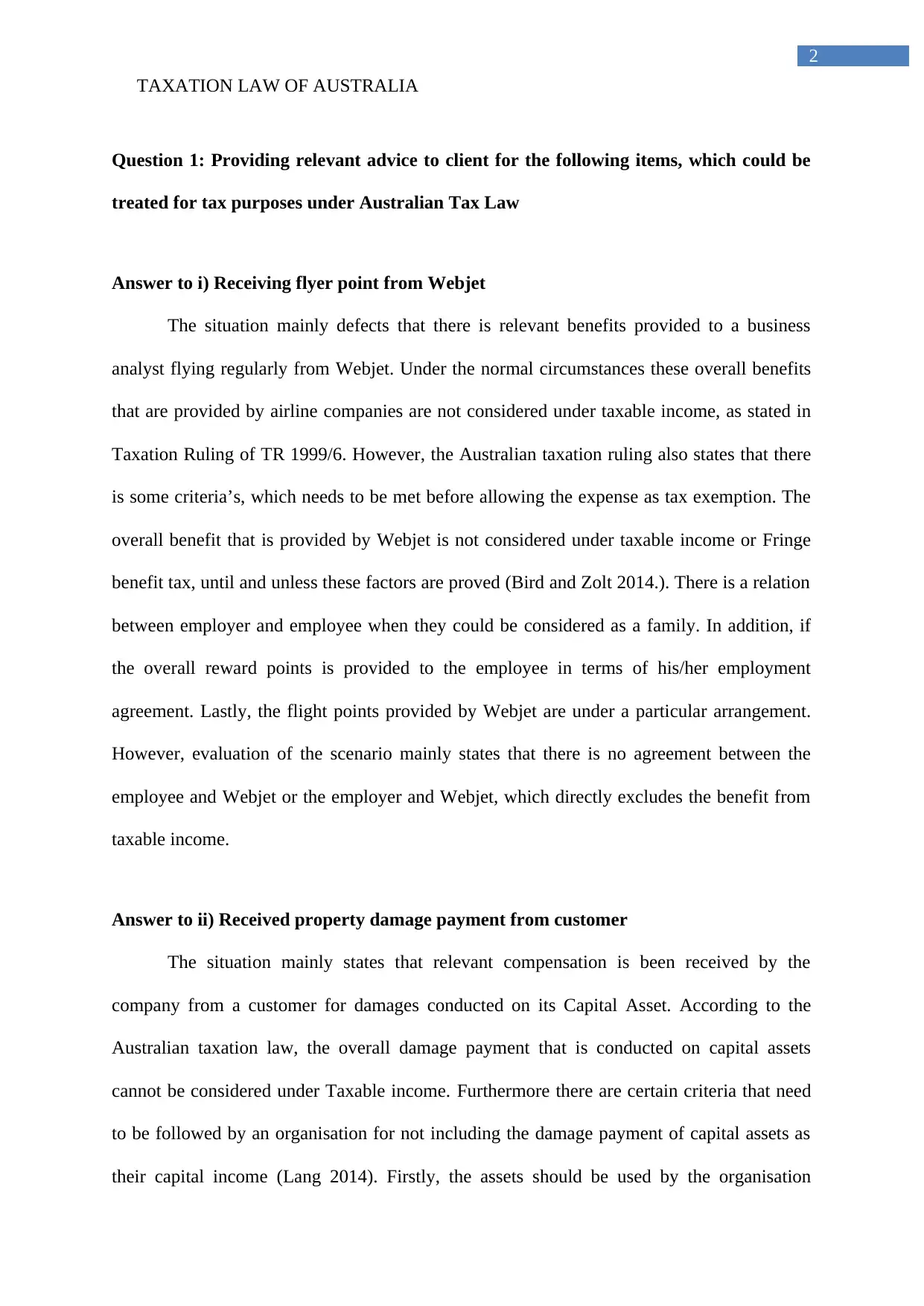
2
TAXATION LAW OF AUSTRALIA
Question 1: Providing relevant advice to client for the following items, which could be
treated for tax purposes under Australian Tax Law
Answer to i) Receiving flyer point from Webjet
The situation mainly defects that there is relevant benefits provided to a business
analyst flying regularly from Webjet. Under the normal circumstances these overall benefits
that are provided by airline companies are not considered under taxable income, as stated in
Taxation Ruling of TR 1999/6. However, the Australian taxation ruling also states that there
is some criteria’s, which needs to be met before allowing the expense as tax exemption. The
overall benefit that is provided by Webjet is not considered under taxable income or Fringe
benefit tax, until and unless these factors are proved (Bird and Zolt 2014.). There is a relation
between employer and employee when they could be considered as a family. In addition, if
the overall reward points is provided to the employee in terms of his/her employment
agreement. Lastly, the flight points provided by Webjet are under a particular arrangement.
However, evaluation of the scenario mainly states that there is no agreement between the
employee and Webjet or the employer and Webjet, which directly excludes the benefit from
taxable income.
Answer to ii) Received property damage payment from customer
The situation mainly states that relevant compensation is been received by the
company from a customer for damages conducted on its Capital Asset. According to the
Australian taxation law, the overall damage payment that is conducted on capital assets
cannot be considered under Taxable income. Furthermore there are certain criteria that need
to be followed by an organisation for not including the damage payment of capital assets as
their capital income (Lang 2014). Firstly, the assets should be used by the organisation
TAXATION LAW OF AUSTRALIA
Question 1: Providing relevant advice to client for the following items, which could be
treated for tax purposes under Australian Tax Law
Answer to i) Receiving flyer point from Webjet
The situation mainly defects that there is relevant benefits provided to a business
analyst flying regularly from Webjet. Under the normal circumstances these overall benefits
that are provided by airline companies are not considered under taxable income, as stated in
Taxation Ruling of TR 1999/6. However, the Australian taxation ruling also states that there
is some criteria’s, which needs to be met before allowing the expense as tax exemption. The
overall benefit that is provided by Webjet is not considered under taxable income or Fringe
benefit tax, until and unless these factors are proved (Bird and Zolt 2014.). There is a relation
between employer and employee when they could be considered as a family. In addition, if
the overall reward points is provided to the employee in terms of his/her employment
agreement. Lastly, the flight points provided by Webjet are under a particular arrangement.
However, evaluation of the scenario mainly states that there is no agreement between the
employee and Webjet or the employer and Webjet, which directly excludes the benefit from
taxable income.
Answer to ii) Received property damage payment from customer
The situation mainly states that relevant compensation is been received by the
company from a customer for damages conducted on its Capital Asset. According to the
Australian taxation law, the overall damage payment that is conducted on capital assets
cannot be considered under Taxable income. Furthermore there are certain criteria that need
to be followed by an organisation for not including the damage payment of capital assets as
their capital income (Lang 2014). Firstly, the assets should be used by the organisation
⊘ This is a preview!⊘
Do you want full access?
Subscribe today to unlock all pages.

Trusted by 1+ million students worldwide
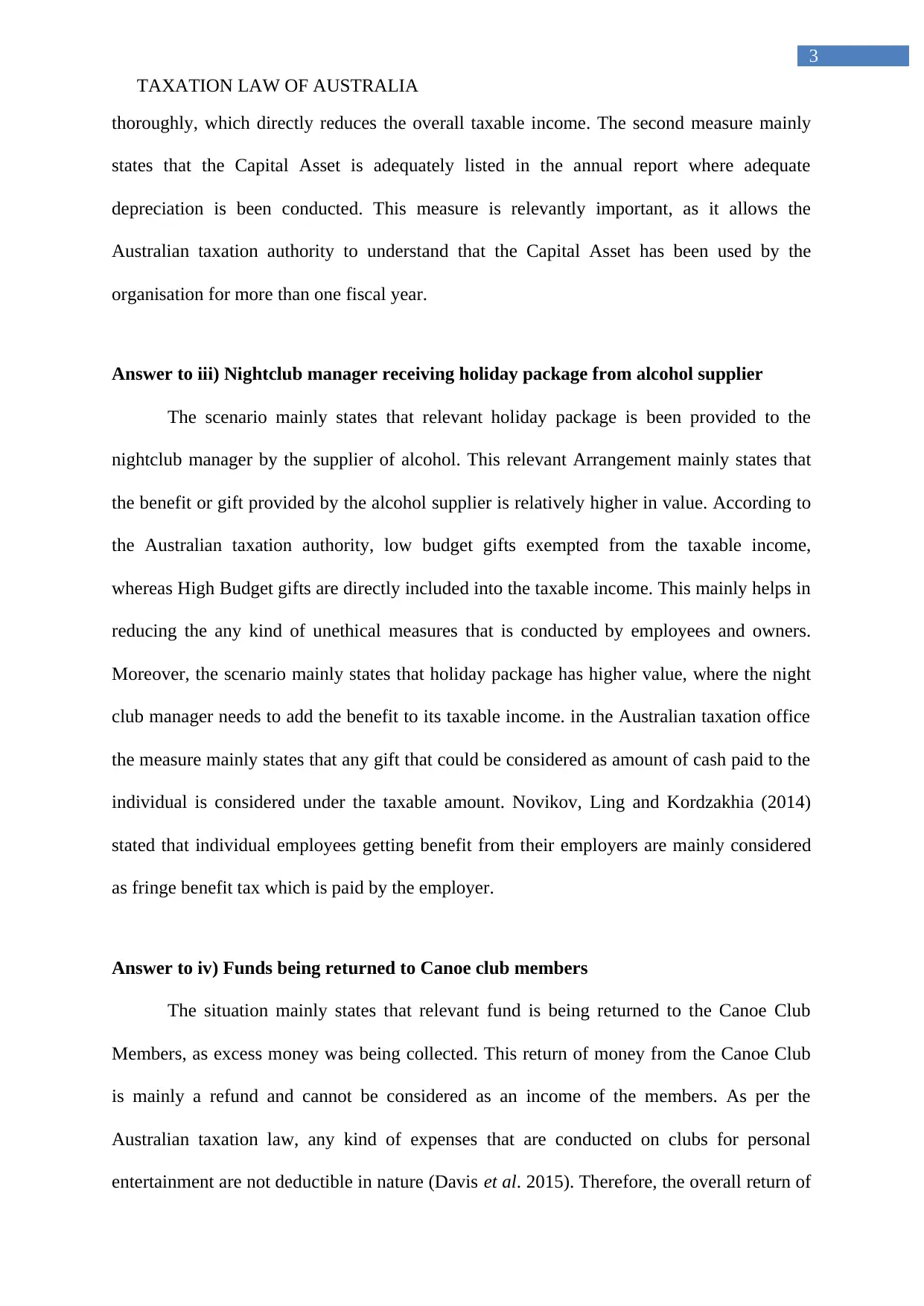
3
TAXATION LAW OF AUSTRALIA
thoroughly, which directly reduces the overall taxable income. The second measure mainly
states that the Capital Asset is adequately listed in the annual report where adequate
depreciation is been conducted. This measure is relevantly important, as it allows the
Australian taxation authority to understand that the Capital Asset has been used by the
organisation for more than one fiscal year.
Answer to iii) Nightclub manager receiving holiday package from alcohol supplier
The scenario mainly states that relevant holiday package is been provided to the
nightclub manager by the supplier of alcohol. This relevant Arrangement mainly states that
the benefit or gift provided by the alcohol supplier is relatively higher in value. According to
the Australian taxation authority, low budget gifts exempted from the taxable income,
whereas High Budget gifts are directly included into the taxable income. This mainly helps in
reducing the any kind of unethical measures that is conducted by employees and owners.
Moreover, the scenario mainly states that holiday package has higher value, where the night
club manager needs to add the benefit to its taxable income. in the Australian taxation office
the measure mainly states that any gift that could be considered as amount of cash paid to the
individual is considered under the taxable amount. Novikov, Ling and Kordzakhia (2014)
stated that individual employees getting benefit from their employers are mainly considered
as fringe benefit tax which is paid by the employer.
Answer to iv) Funds being returned to Canoe club members
The situation mainly states that relevant fund is being returned to the Canoe Club
Members, as excess money was being collected. This return of money from the Canoe Club
is mainly a refund and cannot be considered as an income of the members. As per the
Australian taxation law, any kind of expenses that are conducted on clubs for personal
entertainment are not deductible in nature (Davis et al. 2015). Therefore, the overall return of
TAXATION LAW OF AUSTRALIA
thoroughly, which directly reduces the overall taxable income. The second measure mainly
states that the Capital Asset is adequately listed in the annual report where adequate
depreciation is been conducted. This measure is relevantly important, as it allows the
Australian taxation authority to understand that the Capital Asset has been used by the
organisation for more than one fiscal year.
Answer to iii) Nightclub manager receiving holiday package from alcohol supplier
The scenario mainly states that relevant holiday package is been provided to the
nightclub manager by the supplier of alcohol. This relevant Arrangement mainly states that
the benefit or gift provided by the alcohol supplier is relatively higher in value. According to
the Australian taxation authority, low budget gifts exempted from the taxable income,
whereas High Budget gifts are directly included into the taxable income. This mainly helps in
reducing the any kind of unethical measures that is conducted by employees and owners.
Moreover, the scenario mainly states that holiday package has higher value, where the night
club manager needs to add the benefit to its taxable income. in the Australian taxation office
the measure mainly states that any gift that could be considered as amount of cash paid to the
individual is considered under the taxable amount. Novikov, Ling and Kordzakhia (2014)
stated that individual employees getting benefit from their employers are mainly considered
as fringe benefit tax which is paid by the employer.
Answer to iv) Funds being returned to Canoe club members
The situation mainly states that relevant fund is being returned to the Canoe Club
Members, as excess money was being collected. This return of money from the Canoe Club
is mainly a refund and cannot be considered as an income of the members. As per the
Australian taxation law, any kind of expenses that are conducted on clubs for personal
entertainment are not deductible in nature (Davis et al. 2015). Therefore, the overall return of
Paraphrase This Document
Need a fresh take? Get an instant paraphrase of this document with our AI Paraphraser
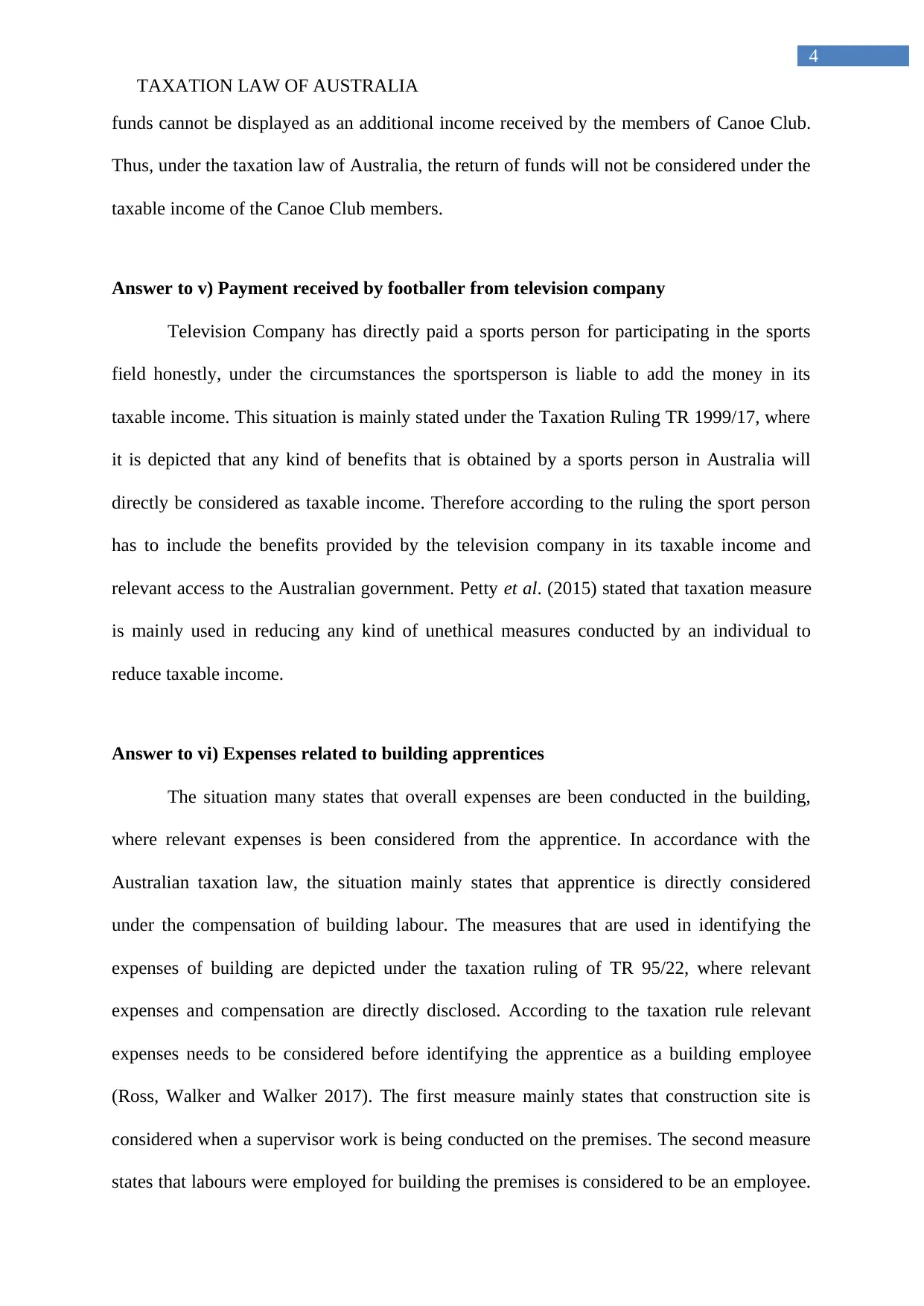
4
TAXATION LAW OF AUSTRALIA
funds cannot be displayed as an additional income received by the members of Canoe Club.
Thus, under the taxation law of Australia, the return of funds will not be considered under the
taxable income of the Canoe Club members.
Answer to v) Payment received by footballer from television company
Television Company has directly paid a sports person for participating in the sports
field honestly, under the circumstances the sportsperson is liable to add the money in its
taxable income. This situation is mainly stated under the Taxation Ruling TR 1999/17, where
it is depicted that any kind of benefits that is obtained by a sports person in Australia will
directly be considered as taxable income. Therefore according to the ruling the sport person
has to include the benefits provided by the television company in its taxable income and
relevant access to the Australian government. Petty et al. (2015) stated that taxation measure
is mainly used in reducing any kind of unethical measures conducted by an individual to
reduce taxable income.
Answer to vi) Expenses related to building apprentices
The situation many states that overall expenses are been conducted in the building,
where relevant expenses is been considered from the apprentice. In accordance with the
Australian taxation law, the situation mainly states that apprentice is directly considered
under the compensation of building labour. The measures that are used in identifying the
expenses of building are depicted under the taxation ruling of TR 95/22, where relevant
expenses and compensation are directly disclosed. According to the taxation rule relevant
expenses needs to be considered before identifying the apprentice as a building employee
(Ross, Walker and Walker 2017). The first measure mainly states that construction site is
considered when a supervisor work is being conducted on the premises. The second measure
states that labours were employed for building the premises is considered to be an employee.
TAXATION LAW OF AUSTRALIA
funds cannot be displayed as an additional income received by the members of Canoe Club.
Thus, under the taxation law of Australia, the return of funds will not be considered under the
taxable income of the Canoe Club members.
Answer to v) Payment received by footballer from television company
Television Company has directly paid a sports person for participating in the sports
field honestly, under the circumstances the sportsperson is liable to add the money in its
taxable income. This situation is mainly stated under the Taxation Ruling TR 1999/17, where
it is depicted that any kind of benefits that is obtained by a sports person in Australia will
directly be considered as taxable income. Therefore according to the ruling the sport person
has to include the benefits provided by the television company in its taxable income and
relevant access to the Australian government. Petty et al. (2015) stated that taxation measure
is mainly used in reducing any kind of unethical measures conducted by an individual to
reduce taxable income.
Answer to vi) Expenses related to building apprentices
The situation many states that overall expenses are been conducted in the building,
where relevant expenses is been considered from the apprentice. In accordance with the
Australian taxation law, the situation mainly states that apprentice is directly considered
under the compensation of building labour. The measures that are used in identifying the
expenses of building are depicted under the taxation ruling of TR 95/22, where relevant
expenses and compensation are directly disclosed. According to the taxation rule relevant
expenses needs to be considered before identifying the apprentice as a building employee
(Ross, Walker and Walker 2017). The first measure mainly states that construction site is
considered when a supervisor work is being conducted on the premises. The second measure
states that labours were employed for building the premises is considered to be an employee.
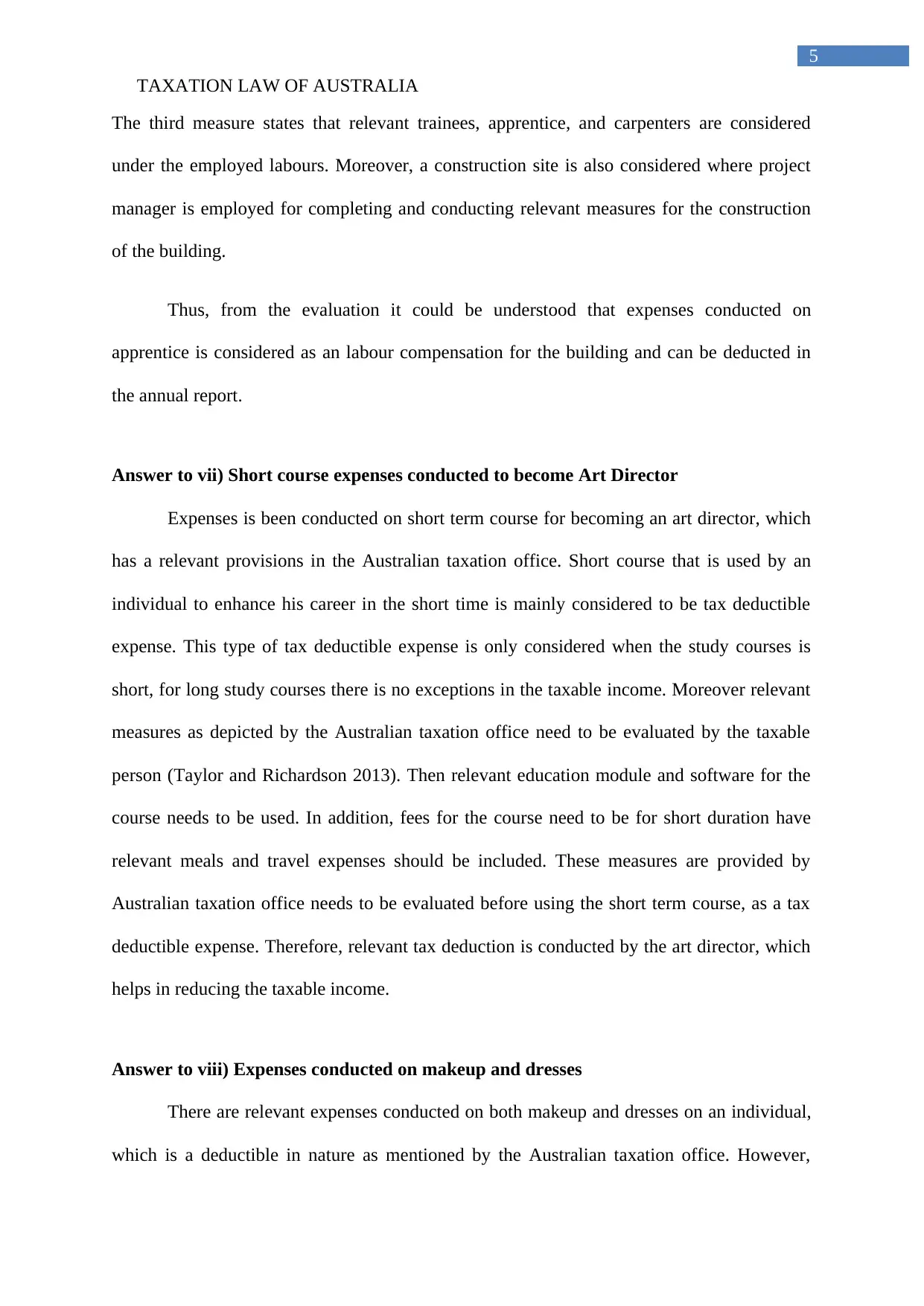
5
TAXATION LAW OF AUSTRALIA
The third measure states that relevant trainees, apprentice, and carpenters are considered
under the employed labours. Moreover, a construction site is also considered where project
manager is employed for completing and conducting relevant measures for the construction
of the building.
Thus, from the evaluation it could be understood that expenses conducted on
apprentice is considered as an labour compensation for the building and can be deducted in
the annual report.
Answer to vii) Short course expenses conducted to become Art Director
Expenses is been conducted on short term course for becoming an art director, which
has a relevant provisions in the Australian taxation office. Short course that is used by an
individual to enhance his career in the short time is mainly considered to be tax deductible
expense. This type of tax deductible expense is only considered when the study courses is
short, for long study courses there is no exceptions in the taxable income. Moreover relevant
measures as depicted by the Australian taxation office need to be evaluated by the taxable
person (Taylor and Richardson 2013). Then relevant education module and software for the
course needs to be used. In addition, fees for the course need to be for short duration have
relevant meals and travel expenses should be included. These measures are provided by
Australian taxation office needs to be evaluated before using the short term course, as a tax
deductible expense. Therefore, relevant tax deduction is conducted by the art director, which
helps in reducing the taxable income.
Answer to viii) Expenses conducted on makeup and dresses
There are relevant expenses conducted on both makeup and dresses on an individual,
which is a deductible in nature as mentioned by the Australian taxation office. However,
TAXATION LAW OF AUSTRALIA
The third measure states that relevant trainees, apprentice, and carpenters are considered
under the employed labours. Moreover, a construction site is also considered where project
manager is employed for completing and conducting relevant measures for the construction
of the building.
Thus, from the evaluation it could be understood that expenses conducted on
apprentice is considered as an labour compensation for the building and can be deducted in
the annual report.
Answer to vii) Short course expenses conducted to become Art Director
Expenses is been conducted on short term course for becoming an art director, which
has a relevant provisions in the Australian taxation office. Short course that is used by an
individual to enhance his career in the short time is mainly considered to be tax deductible
expense. This type of tax deductible expense is only considered when the study courses is
short, for long study courses there is no exceptions in the taxable income. Moreover relevant
measures as depicted by the Australian taxation office need to be evaluated by the taxable
person (Taylor and Richardson 2013). Then relevant education module and software for the
course needs to be used. In addition, fees for the course need to be for short duration have
relevant meals and travel expenses should be included. These measures are provided by
Australian taxation office needs to be evaluated before using the short term course, as a tax
deductible expense. Therefore, relevant tax deduction is conducted by the art director, which
helps in reducing the taxable income.
Answer to viii) Expenses conducted on makeup and dresses
There are relevant expenses conducted on both makeup and dresses on an individual,
which is a deductible in nature as mentioned by the Australian taxation office. However,
⊘ This is a preview!⊘
Do you want full access?
Subscribe today to unlock all pages.

Trusted by 1+ million students worldwide
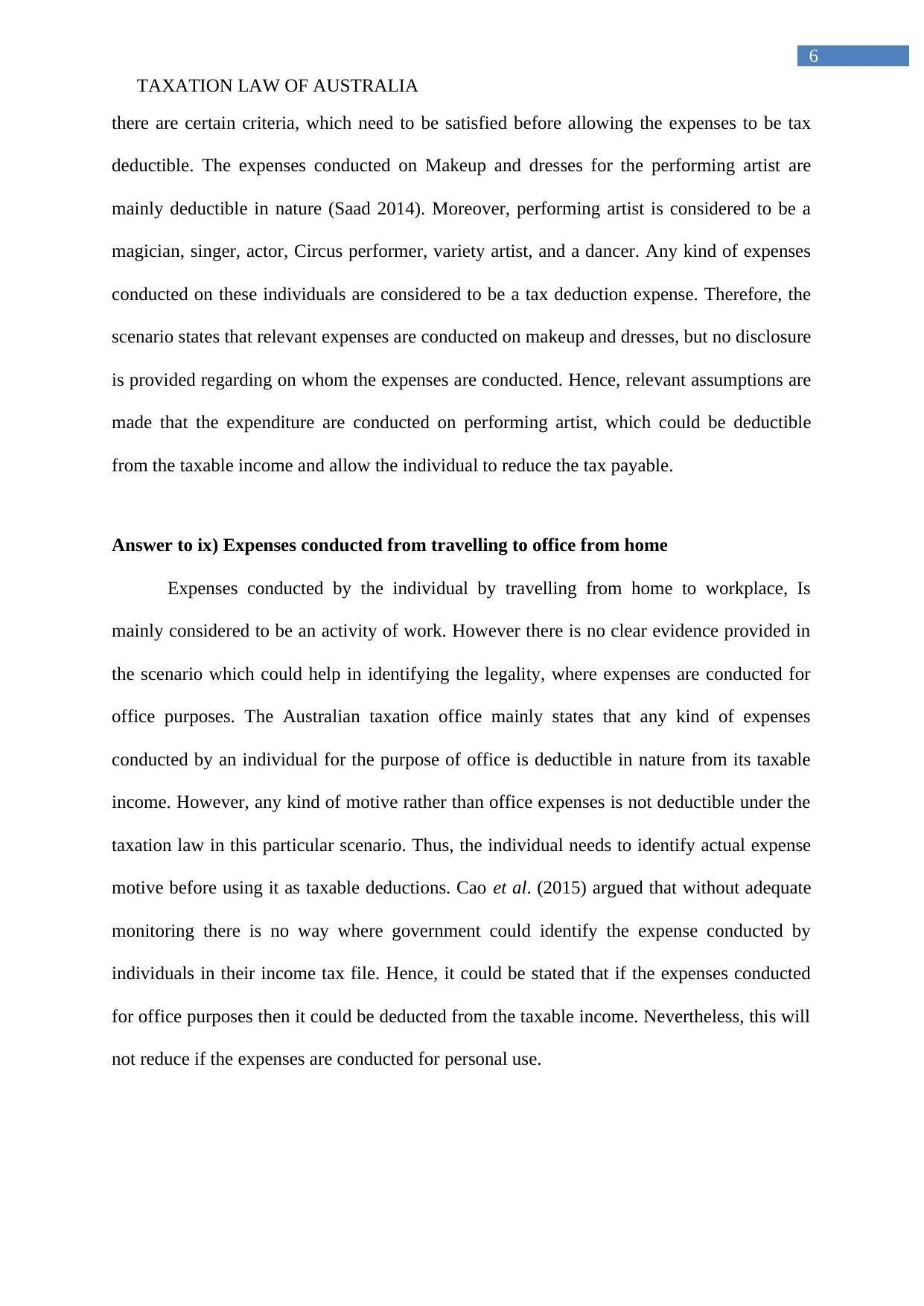
6
TAXATION LAW OF AUSTRALIA
there are certain criteria, which need to be satisfied before allowing the expenses to be tax
deductible. The expenses conducted on Makeup and dresses for the performing artist are
mainly deductible in nature (Saad 2014). Moreover, performing artist is considered to be a
magician, singer, actor, Circus performer, variety artist, and a dancer. Any kind of expenses
conducted on these individuals are considered to be a tax deduction expense. Therefore, the
scenario states that relevant expenses are conducted on makeup and dresses, but no disclosure
is provided regarding on whom the expenses are conducted. Hence, relevant assumptions are
made that the expenditure are conducted on performing artist, which could be deductible
from the taxable income and allow the individual to reduce the tax payable.
Answer to ix) Expenses conducted from travelling to office from home
Expenses conducted by the individual by travelling from home to workplace, Is
mainly considered to be an activity of work. However there is no clear evidence provided in
the scenario which could help in identifying the legality, where expenses are conducted for
office purposes. The Australian taxation office mainly states that any kind of expenses
conducted by an individual for the purpose of office is deductible in nature from its taxable
income. However, any kind of motive rather than office expenses is not deductible under the
taxation law in this particular scenario. Thus, the individual needs to identify actual expense
motive before using it as taxable deductions. Cao et al. (2015) argued that without adequate
monitoring there is no way where government could identify the expense conducted by
individuals in their income tax file. Hence, it could be stated that if the expenses conducted
for office purposes then it could be deducted from the taxable income. Nevertheless, this will
not reduce if the expenses are conducted for personal use.
TAXATION LAW OF AUSTRALIA
there are certain criteria, which need to be satisfied before allowing the expenses to be tax
deductible. The expenses conducted on Makeup and dresses for the performing artist are
mainly deductible in nature (Saad 2014). Moreover, performing artist is considered to be a
magician, singer, actor, Circus performer, variety artist, and a dancer. Any kind of expenses
conducted on these individuals are considered to be a tax deduction expense. Therefore, the
scenario states that relevant expenses are conducted on makeup and dresses, but no disclosure
is provided regarding on whom the expenses are conducted. Hence, relevant assumptions are
made that the expenditure are conducted on performing artist, which could be deductible
from the taxable income and allow the individual to reduce the tax payable.
Answer to ix) Expenses conducted from travelling to office from home
Expenses conducted by the individual by travelling from home to workplace, Is
mainly considered to be an activity of work. However there is no clear evidence provided in
the scenario which could help in identifying the legality, where expenses are conducted for
office purposes. The Australian taxation office mainly states that any kind of expenses
conducted by an individual for the purpose of office is deductible in nature from its taxable
income. However, any kind of motive rather than office expenses is not deductible under the
taxation law in this particular scenario. Thus, the individual needs to identify actual expense
motive before using it as taxable deductions. Cao et al. (2015) argued that without adequate
monitoring there is no way where government could identify the expense conducted by
individuals in their income tax file. Hence, it could be stated that if the expenses conducted
for office purposes then it could be deducted from the taxable income. Nevertheless, this will
not reduce if the expenses are conducted for personal use.
Paraphrase This Document
Need a fresh take? Get an instant paraphrase of this document with our AI Paraphraser
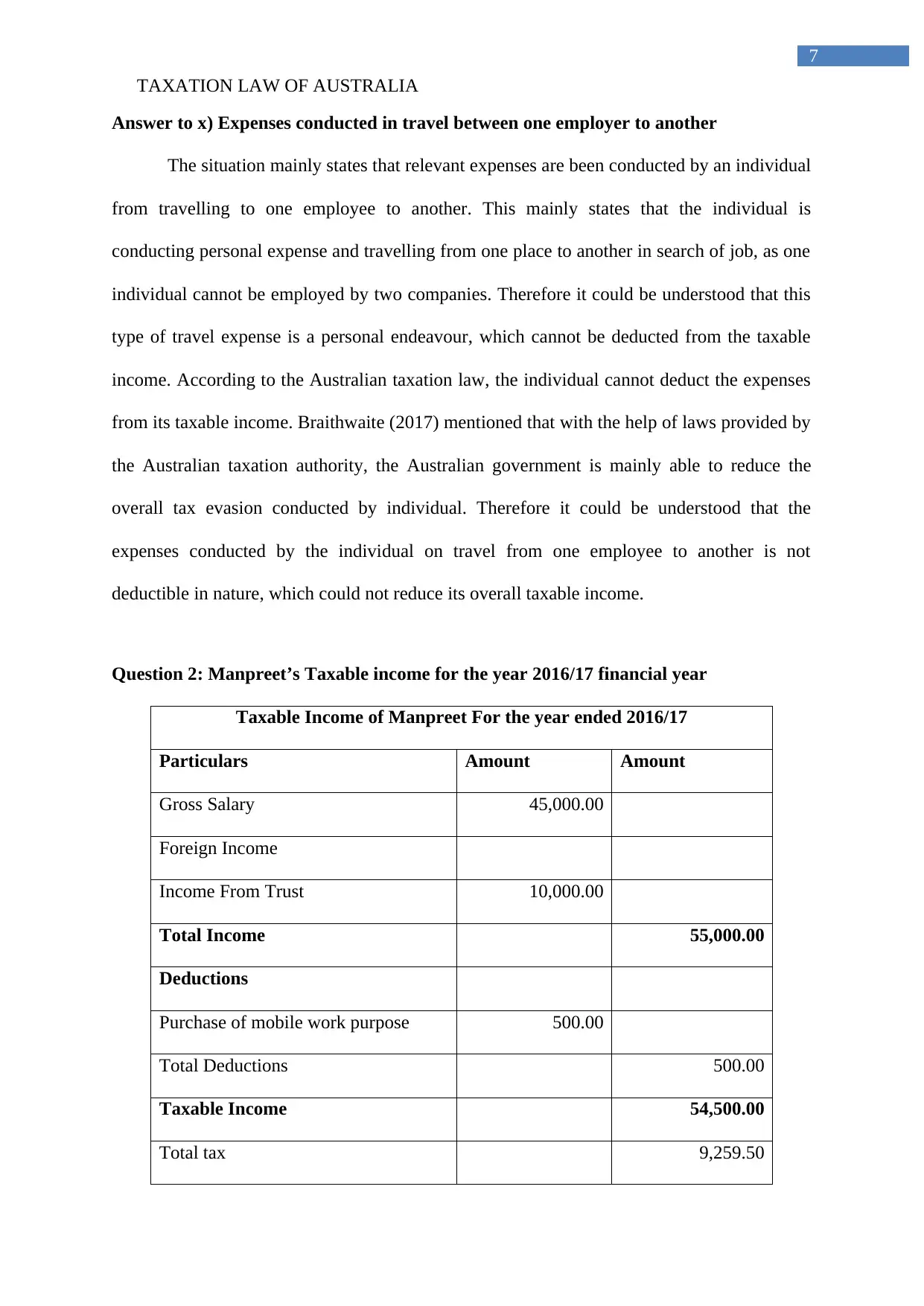
7
TAXATION LAW OF AUSTRALIA
Answer to x) Expenses conducted in travel between one employer to another
The situation mainly states that relevant expenses are been conducted by an individual
from travelling to one employee to another. This mainly states that the individual is
conducting personal expense and travelling from one place to another in search of job, as one
individual cannot be employed by two companies. Therefore it could be understood that this
type of travel expense is a personal endeavour, which cannot be deducted from the taxable
income. According to the Australian taxation law, the individual cannot deduct the expenses
from its taxable income. Braithwaite (2017) mentioned that with the help of laws provided by
the Australian taxation authority, the Australian government is mainly able to reduce the
overall tax evasion conducted by individual. Therefore it could be understood that the
expenses conducted by the individual on travel from one employee to another is not
deductible in nature, which could not reduce its overall taxable income.
Question 2: Manpreet’s Taxable income for the year 2016/17 financial year
Taxable Income of Manpreet For the year ended 2016/17
Particulars Amount Amount
Gross Salary 45,000.00
Foreign Income
Income From Trust 10,000.00
Total Income 55,000.00
Deductions
Purchase of mobile work purpose 500.00
Total Deductions 500.00
Taxable Income 54,500.00
Total tax 9,259.50
TAXATION LAW OF AUSTRALIA
Answer to x) Expenses conducted in travel between one employer to another
The situation mainly states that relevant expenses are been conducted by an individual
from travelling to one employee to another. This mainly states that the individual is
conducting personal expense and travelling from one place to another in search of job, as one
individual cannot be employed by two companies. Therefore it could be understood that this
type of travel expense is a personal endeavour, which cannot be deducted from the taxable
income. According to the Australian taxation law, the individual cannot deduct the expenses
from its taxable income. Braithwaite (2017) mentioned that with the help of laws provided by
the Australian taxation authority, the Australian government is mainly able to reduce the
overall tax evasion conducted by individual. Therefore it could be understood that the
expenses conducted by the individual on travel from one employee to another is not
deductible in nature, which could not reduce its overall taxable income.
Question 2: Manpreet’s Taxable income for the year 2016/17 financial year
Taxable Income of Manpreet For the year ended 2016/17
Particulars Amount Amount
Gross Salary 45,000.00
Foreign Income
Income From Trust 10,000.00
Total Income 55,000.00
Deductions
Purchase of mobile work purpose 500.00
Total Deductions 500.00
Taxable Income 54,500.00
Total tax 9,259.50
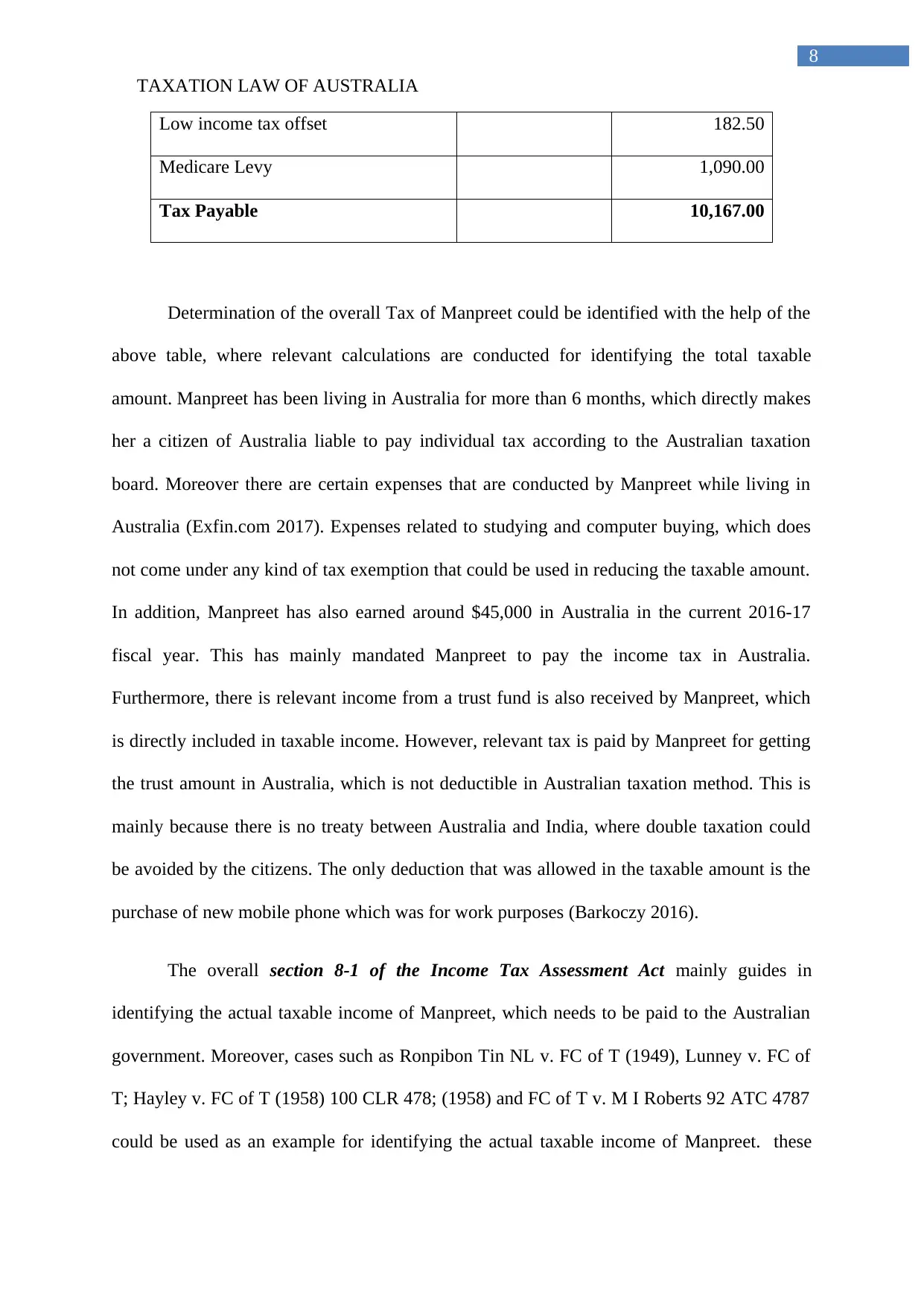
8
TAXATION LAW OF AUSTRALIA
Low income tax offset 182.50
Medicare Levy 1,090.00
Tax Payable 10,167.00
Determination of the overall Tax of Manpreet could be identified with the help of the
above table, where relevant calculations are conducted for identifying the total taxable
amount. Manpreet has been living in Australia for more than 6 months, which directly makes
her a citizen of Australia liable to pay individual tax according to the Australian taxation
board. Moreover there are certain expenses that are conducted by Manpreet while living in
Australia (Exfin.com 2017). Expenses related to studying and computer buying, which does
not come under any kind of tax exemption that could be used in reducing the taxable amount.
In addition, Manpreet has also earned around $45,000 in Australia in the current 2016-17
fiscal year. This has mainly mandated Manpreet to pay the income tax in Australia.
Furthermore, there is relevant income from a trust fund is also received by Manpreet, which
is directly included in taxable income. However, relevant tax is paid by Manpreet for getting
the trust amount in Australia, which is not deductible in Australian taxation method. This is
mainly because there is no treaty between Australia and India, where double taxation could
be avoided by the citizens. The only deduction that was allowed in the taxable amount is the
purchase of new mobile phone which was for work purposes (Barkoczy 2016).
The overall section 8-1 of the Income Tax Assessment Act mainly guides in
identifying the actual taxable income of Manpreet, which needs to be paid to the Australian
government. Moreover, cases such as Ronpibon Tin NL v. FC of T (1949), Lunney v. FC of
T; Hayley v. FC of T (1958) 100 CLR 478; (1958) and FC of T v. M I Roberts 92 ATC 4787
could be used as an example for identifying the actual taxable income of Manpreet. these
TAXATION LAW OF AUSTRALIA
Low income tax offset 182.50
Medicare Levy 1,090.00
Tax Payable 10,167.00
Determination of the overall Tax of Manpreet could be identified with the help of the
above table, where relevant calculations are conducted for identifying the total taxable
amount. Manpreet has been living in Australia for more than 6 months, which directly makes
her a citizen of Australia liable to pay individual tax according to the Australian taxation
board. Moreover there are certain expenses that are conducted by Manpreet while living in
Australia (Exfin.com 2017). Expenses related to studying and computer buying, which does
not come under any kind of tax exemption that could be used in reducing the taxable amount.
In addition, Manpreet has also earned around $45,000 in Australia in the current 2016-17
fiscal year. This has mainly mandated Manpreet to pay the income tax in Australia.
Furthermore, there is relevant income from a trust fund is also received by Manpreet, which
is directly included in taxable income. However, relevant tax is paid by Manpreet for getting
the trust amount in Australia, which is not deductible in Australian taxation method. This is
mainly because there is no treaty between Australia and India, where double taxation could
be avoided by the citizens. The only deduction that was allowed in the taxable amount is the
purchase of new mobile phone which was for work purposes (Barkoczy 2016).
The overall section 8-1 of the Income Tax Assessment Act mainly guides in
identifying the actual taxable income of Manpreet, which needs to be paid to the Australian
government. Moreover, cases such as Ronpibon Tin NL v. FC of T (1949), Lunney v. FC of
T; Hayley v. FC of T (1958) 100 CLR 478; (1958) and FC of T v. M I Roberts 92 ATC 4787
could be used as an example for identifying the actual taxable income of Manpreet. these
⊘ This is a preview!⊘
Do you want full access?
Subscribe today to unlock all pages.

Trusted by 1+ million students worldwide
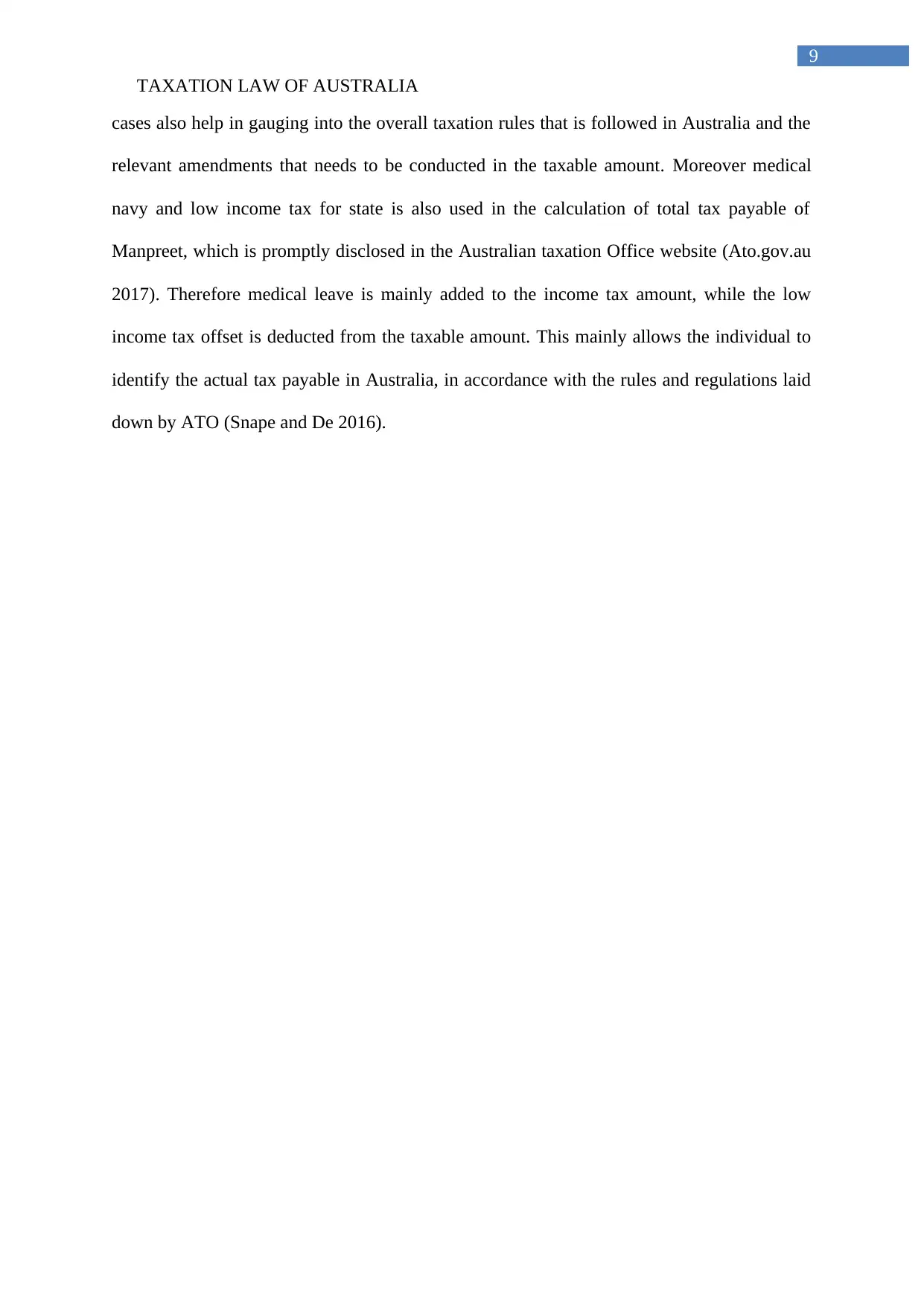
9
TAXATION LAW OF AUSTRALIA
cases also help in gauging into the overall taxation rules that is followed in Australia and the
relevant amendments that needs to be conducted in the taxable amount. Moreover medical
navy and low income tax for state is also used in the calculation of total tax payable of
Manpreet, which is promptly disclosed in the Australian taxation Office website (Ato.gov.au
2017). Therefore medical leave is mainly added to the income tax amount, while the low
income tax offset is deducted from the taxable amount. This mainly allows the individual to
identify the actual tax payable in Australia, in accordance with the rules and regulations laid
down by ATO (Snape and De 2016).
TAXATION LAW OF AUSTRALIA
cases also help in gauging into the overall taxation rules that is followed in Australia and the
relevant amendments that needs to be conducted in the taxable amount. Moreover medical
navy and low income tax for state is also used in the calculation of total tax payable of
Manpreet, which is promptly disclosed in the Australian taxation Office website (Ato.gov.au
2017). Therefore medical leave is mainly added to the income tax amount, while the low
income tax offset is deducted from the taxable amount. This mainly allows the individual to
identify the actual tax payable in Australia, in accordance with the rules and regulations laid
down by ATO (Snape and De 2016).
Paraphrase This Document
Need a fresh take? Get an instant paraphrase of this document with our AI Paraphraser
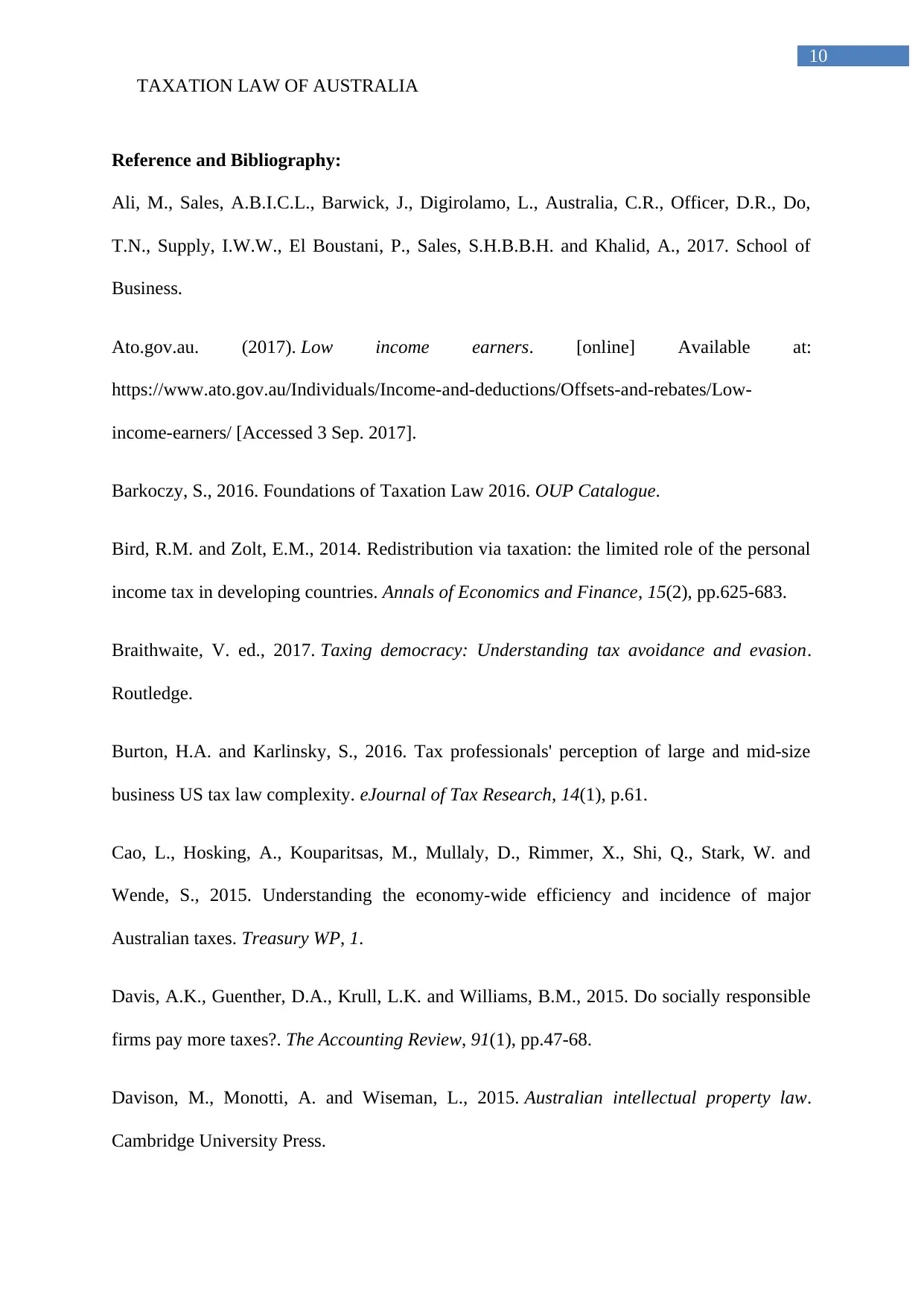
10
TAXATION LAW OF AUSTRALIA
Reference and Bibliography:
Ali, M., Sales, A.B.I.C.L., Barwick, J., Digirolamo, L., Australia, C.R., Officer, D.R., Do,
T.N., Supply, I.W.W., El Boustani, P., Sales, S.H.B.B.H. and Khalid, A., 2017. School of
Business.
Ato.gov.au. (2017). Low income earners. [online] Available at:
https://www.ato.gov.au/Individuals/Income-and-deductions/Offsets-and-rebates/Low-
income-earners/ [Accessed 3 Sep. 2017].
Barkoczy, S., 2016. Foundations of Taxation Law 2016. OUP Catalogue.
Bird, R.M. and Zolt, E.M., 2014. Redistribution via taxation: the limited role of the personal
income tax in developing countries. Annals of Economics and Finance, 15(2), pp.625-683.
Braithwaite, V. ed., 2017. Taxing democracy: Understanding tax avoidance and evasion.
Routledge.
Burton, H.A. and Karlinsky, S., 2016. Tax professionals' perception of large and mid-size
business US tax law complexity. eJournal of Tax Research, 14(1), p.61.
Cao, L., Hosking, A., Kouparitsas, M., Mullaly, D., Rimmer, X., Shi, Q., Stark, W. and
Wende, S., 2015. Understanding the economy-wide efficiency and incidence of major
Australian taxes. Treasury WP, 1.
Davis, A.K., Guenther, D.A., Krull, L.K. and Williams, B.M., 2015. Do socially responsible
firms pay more taxes?. The Accounting Review, 91(1), pp.47-68.
Davison, M., Monotti, A. and Wiseman, L., 2015. Australian intellectual property law.
Cambridge University Press.
TAXATION LAW OF AUSTRALIA
Reference and Bibliography:
Ali, M., Sales, A.B.I.C.L., Barwick, J., Digirolamo, L., Australia, C.R., Officer, D.R., Do,
T.N., Supply, I.W.W., El Boustani, P., Sales, S.H.B.B.H. and Khalid, A., 2017. School of
Business.
Ato.gov.au. (2017). Low income earners. [online] Available at:
https://www.ato.gov.au/Individuals/Income-and-deductions/Offsets-and-rebates/Low-
income-earners/ [Accessed 3 Sep. 2017].
Barkoczy, S., 2016. Foundations of Taxation Law 2016. OUP Catalogue.
Bird, R.M. and Zolt, E.M., 2014. Redistribution via taxation: the limited role of the personal
income tax in developing countries. Annals of Economics and Finance, 15(2), pp.625-683.
Braithwaite, V. ed., 2017. Taxing democracy: Understanding tax avoidance and evasion.
Routledge.
Burton, H.A. and Karlinsky, S., 2016. Tax professionals' perception of large and mid-size
business US tax law complexity. eJournal of Tax Research, 14(1), p.61.
Cao, L., Hosking, A., Kouparitsas, M., Mullaly, D., Rimmer, X., Shi, Q., Stark, W. and
Wende, S., 2015. Understanding the economy-wide efficiency and incidence of major
Australian taxes. Treasury WP, 1.
Davis, A.K., Guenther, D.A., Krull, L.K. and Williams, B.M., 2015. Do socially responsible
firms pay more taxes?. The Accounting Review, 91(1), pp.47-68.
Davison, M., Monotti, A. and Wiseman, L., 2015. Australian intellectual property law.
Cambridge University Press.

11
TAXATION LAW OF AUSTRALIA
Douglas, H., Bartlett, F., Luker, T. and Hunter, R. eds., 2014. Australian feminist judgments:
Righting and rewriting law. Bloomsbury Publishing.
Exfin.com. (2017). Current Australian IncomeTax Rates - Resident and Non-Resident | Exfin
- The Australian Expatriate's Gateway. [online] Available at:
https://www.exfin.com/australian-tax-rates [Accessed 3 Sep. 2017].
Lang, M., 2014. Introduction to the law of double taxation conventions. Linde Verlag GmbH.
Novikov, A.A., Ling, T.G. and Kordzakhia, N., 2014. Pricing of volume-weighted average
options: Analytical approximations and numerical results. In Inspired by Finance (pp. 461-
474). Springer International Publishing.
Petty, J.W., Titman, S., Keown, A.J., Martin, P., Martin, J.D. and Burrow, M.,
2015. Financial management: Principles and applications. Pearson Higher Education AU.
Ross, M., Walker, J. and Walker, J., 2017. Multinationals targeted down under. Taxation in
Australia, 52(1), p.22.
Saad, N., 2014. Tax knowledge, tax complexity and tax compliance: Taxpayers’
view. Procedia-Social and Behavioral Sciences, 109, pp.1069-1075.
Snape, J. and De Souza, J., 2016. Environmental taxation law: policy, contexts and practice.
Routledge.
Taylor, G. and Richardson, G., 2013. The determinants of thinly capitalized tax avoidance
structures: Evidence from Australian firms. Journal of International Accounting, Auditing
and Taxation, 22(1), pp.12-25.
TAXATION LAW OF AUSTRALIA
Douglas, H., Bartlett, F., Luker, T. and Hunter, R. eds., 2014. Australian feminist judgments:
Righting and rewriting law. Bloomsbury Publishing.
Exfin.com. (2017). Current Australian IncomeTax Rates - Resident and Non-Resident | Exfin
- The Australian Expatriate's Gateway. [online] Available at:
https://www.exfin.com/australian-tax-rates [Accessed 3 Sep. 2017].
Lang, M., 2014. Introduction to the law of double taxation conventions. Linde Verlag GmbH.
Novikov, A.A., Ling, T.G. and Kordzakhia, N., 2014. Pricing of volume-weighted average
options: Analytical approximations and numerical results. In Inspired by Finance (pp. 461-
474). Springer International Publishing.
Petty, J.W., Titman, S., Keown, A.J., Martin, P., Martin, J.D. and Burrow, M.,
2015. Financial management: Principles and applications. Pearson Higher Education AU.
Ross, M., Walker, J. and Walker, J., 2017. Multinationals targeted down under. Taxation in
Australia, 52(1), p.22.
Saad, N., 2014. Tax knowledge, tax complexity and tax compliance: Taxpayers’
view. Procedia-Social and Behavioral Sciences, 109, pp.1069-1075.
Snape, J. and De Souza, J., 2016. Environmental taxation law: policy, contexts and practice.
Routledge.
Taylor, G. and Richardson, G., 2013. The determinants of thinly capitalized tax avoidance
structures: Evidence from Australian firms. Journal of International Accounting, Auditing
and Taxation, 22(1), pp.12-25.
⊘ This is a preview!⊘
Do you want full access?
Subscribe today to unlock all pages.

Trusted by 1+ million students worldwide
1 out of 12
Related Documents
Your All-in-One AI-Powered Toolkit for Academic Success.
+13062052269
info@desklib.com
Available 24*7 on WhatsApp / Email
![[object Object]](/_next/static/media/star-bottom.7253800d.svg)
Unlock your academic potential
Copyright © 2020–2025 A2Z Services. All Rights Reserved. Developed and managed by ZUCOL.





